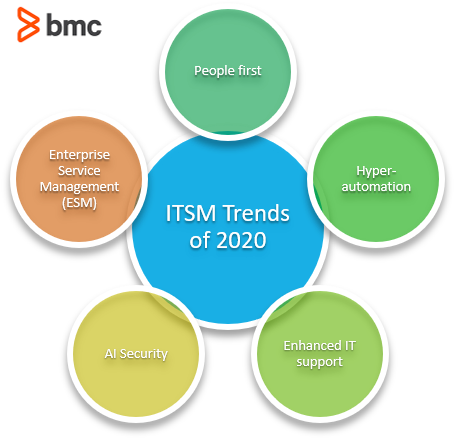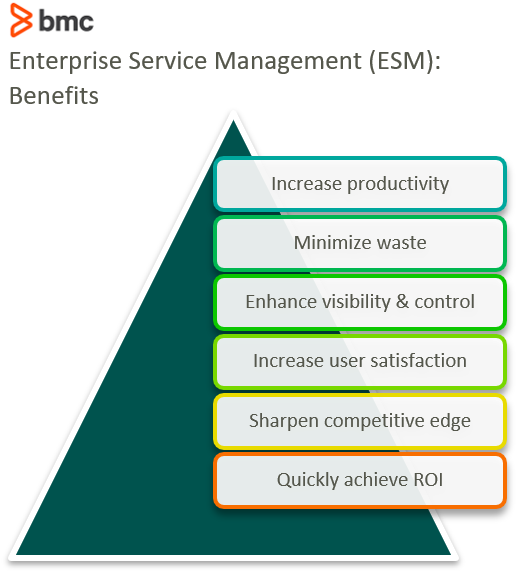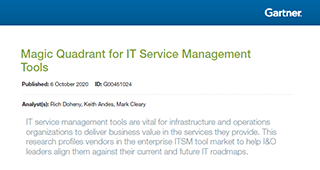Despite the massive changes we’ve all experienced this year, some things remain steady. In the world IT service management, that’s certainly the case.
If there is a major theme that ITSM organizations have learned this year, it’s that your people matter more than anything. Having talented and dedicated workers on your team is among the most crucial factors to business success.
What else is happening in ITSM this year? Has the ITSM practice been rocked or has it remained steady? Let’s look at five ITSM trends that have prevailed in 2020.

Trend 1: People first
As mentioned, the biggest lesson companies have learned this year is how important strong employees are to the productivity and overall success of a company. This is not lost on IT sectors. A trend in ITSM is having a people-first approach, with companies emphasizing the value of their workers—over their technology.
ITSM teams are valuing people in two significant ways, both of which have been a long time coming:
- Improving employee engagement and providing a better work-life balance. Companies seem to actually be listening to employees these days, aware of the stresses of at-home work and life. That’s why we see major IT companies like Facebook and Google changing their work-from-home policies for the foreseeable future. Other companies, including BMC, have long valued both in-person and remote work.
- Automating mundane, routine tasks to lighten the workload for the IT team, leaving staff to spend time on more valuable, complex tasks. The technology world has preached automation for years, but experts say this year of such immense change is finally the time for companies to embrace it.
Trend 2: Hyperautomation
As a result of this people-first trend, another ITSM trend in 2020 is hyperautomation. Yes, we have been talking about automating tasks for many years, helping to reduce the need for human intervention for highly predictable and repeating patterns.
Hyperautomation takes that one step further. Hyperautomation combines a variety of technologies, like Artificial Intelligence, Robotic Process Automation, and Machine Learning, to automate processes in significantly more impactful ways.
Companies who harness both their subject matter expertise (in all areas) and hyperautomation will:
- Improve quality
- Reduce costs
- Increase speed and productivity
- Enhance analytics, offering real-time, continuous intelligence for data-driven decision making
Trend 3: Enhanced IT support
With the help of hyperautomation practices, IT support can finally become as strong as it aims to be. Automation is starting to take care of the low-level processes that are necessary, but don’t need the talents of IT professionals to complete them.
With the service desk losing a decent chunk of its tickets to automation, IT support will be able to utilize their valuable staff on more complex issues and critical tasks. These enhanced capabilities will only continue to improve both the end-user and customer experience—furthering the value of ITSM altogether.
Trend 4: AI security
With technologies like AI and ML increasing in usage, it should come as no surprise that cyber criminals have quickly exploited this and found ways to compromise infrastructure. As Forbes recently reported, cybercriminals are integrating AI and machine learning into their malware programs to bypass and infiltrate targeted systems.
It is crucial that ITSM organizations take security seriously and close gaps in any potential vulnerabilities—and AI security, like security analytics, can help. According to Gartner, AI security in 2020 will have three key perspectives:
- Protecting AI-powered systems. Securing AI training data, training pipelines, and ML models.
- Leveraging AI to enhance security defense. Using ML to understand patterns, uncover attacks, and automate parts of the cybersecurity processes.
- Anticipating use of AI by attackers. Identifying attacks in order to defend against them
Trend 5: Enterprise service management
As with other areas of IT, breaking down silos is a major theme in ITSM in 2020, starting with enterprise service management. Enterprise service management (ESM) is the use of ITSM principles and tools to support all functions within the organization, resulting in:
- Increased productivity
- Minimal waste
- Enhanced visibility and control
- Improved user satisfaction
- Sharper competitive edge
- Increased ROI
The popularity and success of ITIL® has prompted other departments to utilize the same strategies outside of IT, including facilities management, accounting, finance, and Human Resources. ESM takes these strategies and uses them to improve efficiency within service design, increasing user satisfaction and supporting business needs.

ITSM is here to stay
ITSM has seen many shifts throughout the years, but 2020 has brought the focus back to the workers who support it and the people who benefit from it. ITSM will continue to become more automated, helping teams, clients, and businesses for years to come.
BMC supports ITSM across the enterprise
BMC Helix is a first-in-class SaaS platform for intelligent, AI-enabled Service and Operations Management. As leaders in ITSM, BMC can help your company become an Autonomous Digital Enterprise—see what that looks like:
Additional resources
For more on ITSM trends and best practices, explore these resources:







